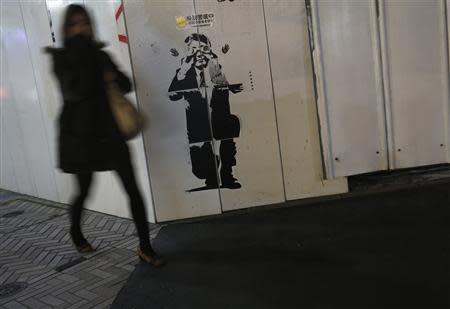Masked artist makes sticky issue out of radiation in Japan
By Sophie Knight TOKYO (Reuters) - With his face hidden behind sunglasses and a white surgical mask, the artist is almost as invisible as the radioactive contamination he is protesting against - yet his stickers are graphic reminders of the Fukushima nuclear disaster. Known as 281 Antinuke, Japan's answer to Banksy has covered Tokyo streets in images depicting politicians as vampires and children being shielded from radioactive rain to highlight the consequences of a meltdown at the Fukushima nuclear plant after an earthquake and tsunami on March 11, 2011. The disaster and the response by plant operator Tokyo Electric Power Co (Tepco) stoked anti-nuclear sentiment and the biggest public protests in Japan since the 1960s, but the movement has since lost momentum. "Perhaps because everyone believes people telling them on television that everything is fine, they don't seem so worried," 281 Antinuke told Reuters. "I hope by leaving my art I can remind people that we're not safe at all ... and that they will do something to protect themselves." 281 Antinuke is a rare instance in a country where graffiti writers face heavy penalties and strong social disapproval. Online commentators have called for his arrest and his agent says the artist has received death threats. But he is determined to keep drawing attention to what he calls "an enormous public contamination disaster". "We don't know what will happen in the future, whether children will get cancer or leukemia," he said. "So I want to keep making noise and making a fuss." He does that under a shroud of secrecy. He refuses to provide any personal details, apart from the fact that 281 is taken from the number on his high school jersey. The only clue to his age is a sprinkling of grey hair poking from under his hoodie. Inspired by punk music and the Sex Pistols' album art by Jamie Reid, many of his bold designs depict children threatened by nuclear power, with the atomic symbol taking the place of flower petals, a biscuit or an inflatable swimming ring. Plastered on lamp posts and walls around central Tokyo, including the Shibuya entertainment district and its famously hectic pedestrian crossing, some of the images are the size of a fist and others as large as a small child. PAY ATTENTION 281 said he started dropping Antinuke from his moniker recently as he tackled topics such as an upcoming hike in consumption tax and Japan's hosting of the 2020 Olympics. "The nuclear accident allowed us to realize that Japan had hidden a lot of things," he said. "I want to make images that express doubts about what's going on in politics - like a label that says 'This is happening, pay attention'." The most politically sensitive stickers have the shortest half-life, usually lasting less than the average of three days it takes before his work is torn down. Although he sees many Japanese people taking photos and uploading them to blogs and Twitter, 281 acknowledges - with a tinge of sadness - that most of his fans are not in Japan, where he wants to have the biggest impact. "It's a shame but 90 percent of the people who get in contact with me are from abroad, maybe because foreigners are more used to looking out for street art with a message," he said. The avant-garde group Chim Pom inserted a painting of the Fukushima plant into a public mural by esteemed artist Taro Okamoto depicting the Hiroshima atomic bomb. Otherwise, the response from high-profile Japanese artists to the nuclear disaster has been subdued. "I don't know why more Japanese artists didn't react. I wonder whether they were moved at all," 281 said. But he realizes the risks in speaking out against the establishment and is careful to maintain his anonymity. "My job is to add color to things that are invisible," he said. "But I don't think I should be seen." (Additional reporting by Chris Meyers; Editing by John O'Callaghan)




